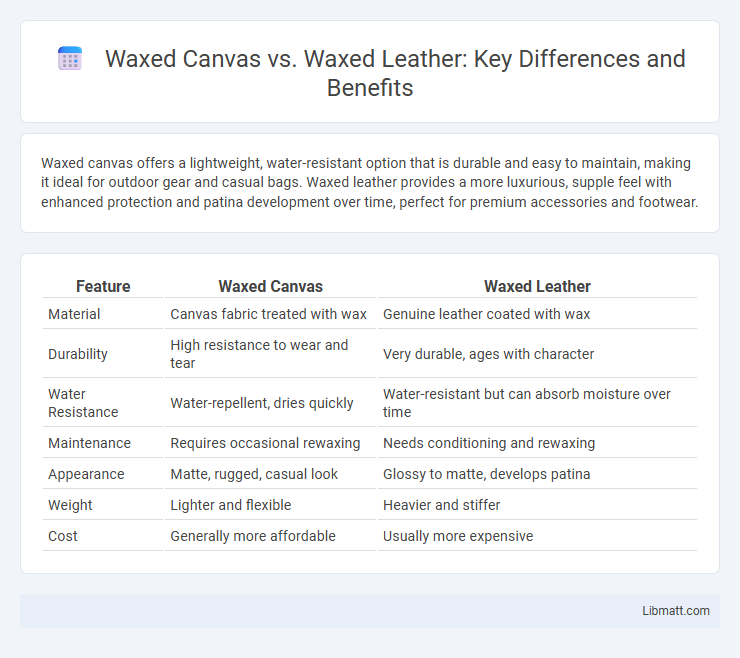Waxed canvas offers a lightweight, water-resistant option that is durable and easy to maintain, making it ideal for outdoor gear and casual bags. Waxed leather provides a more luxurious, supple feel with enhanced protection and patina development over time, perfect for premium accessories and footwear.
Table of Comparison
| Feature | Waxed Canvas | Waxed Leather |
|---|---|---|
| Material | Canvas fabric treated with wax | Genuine leather coated with wax |
| Durability | High resistance to wear and tear | Very durable, ages with character |
| Water Resistance | Water-repellent, dries quickly | Water-resistant but can absorb moisture over time |
| Maintenance | Requires occasional rewaxing | Needs conditioning and rewaxing |
| Appearance | Matte, rugged, casual look | Glossy to matte, develops patina |
| Weight | Lighter and flexible | Heavier and stiffer |
| Cost | Generally more affordable | Usually more expensive |
Introduction to Waxed Canvas and Waxed Leather
Waxed canvas is a durable fabric treated with a layer of wax to enhance water resistance and longevity, commonly used in outdoor gear and bags. Waxed leather undergoes a similar waxing process to create a glossy, protective finish that improves durability and repels moisture while maintaining the natural texture of leather. Both materials offer unique benefits in terms of weather resistance and aesthetic appeal, making them popular choices for rugged, stylish accessories.
Material Origins and Composition
Waxed canvas originates from woven cotton or linen fabric treated with a wax coating to provide water resistance and durability, making it lightweight yet sturdy. Waxed leather, crafted from animal hides, undergoes a waxing process that enhances its natural suppleness, water repellency, and develops a unique patina over time. Your choice between these materials depends on whether you prioritize the fabric's textile heritage or the organic properties of treated leather.
Durability and Longevity Comparison
Waxed canvas offers exceptional durability due to its water-resistant coating and resistance to abrasions, often lasting several years with proper care. Waxed leather provides superior longevity with natural oils that enhance flexibility and develop a unique patina over time, making it highly resilient to wear and tear. Both materials age well, but waxed leather generally outperforms waxed canvas in long-term durability and aesthetic evolution.
Water Resistance: Canvas vs Leather
Waxed canvas offers superior water resistance by absorbing a beeswax-based coating that repels moisture while maintaining breathability, making it ideal for outdoor gear. Waxed leather provides strong water resistance through a treated surface that prevents water penetration but requires more maintenance to avoid cracking or stiffening. Both materials excel in water resistance, but waxed canvas tends to retain flexibility better when exposed to wet conditions.
Maintenance and Care Requirements
Waxed canvas demands less intensive maintenance, requiring occasional re-waxing to maintain its water-resistant properties and simple cleaning with a damp cloth. Waxed leather, however, needs more attentive care, including conditioning with leather-specific products to prevent drying and cracking, along with careful cleaning to preserve its finish. Your choice will influence how much time and effort you invest in upkeep to keep the material looking its best.
Aesthetic Appeal and Aging Process
Waxed canvas offers a rugged, matte finish that develops a unique, distressed patina over time, enhancing its vintage aesthetic and water-resistant properties. Waxed leather presents a richer, glossy surface that deepens in color and softness with age, gaining character while maintaining durability. Both materials showcase distinct aging processes that appeal to those seeking functional style with evolving visual appeal.
Environmental Impact and Sustainability
Waxed canvas is generally more environmentally sustainable due to its natural cotton base, which is biodegradable and often sourced from renewable materials, while the waxing process typically employs natural beeswax or soy-based waxes. Waxed leather, derived from animal hides, involves resource-intensive livestock farming that contributes to higher greenhouse gas emissions and deforestation, raising significant environmental concerns. However, full lifecycle assessment depends on factors such as durability, with waxed leather's longevity potentially offsetting some environmental impact through reduced replacement frequency.
Typical Uses and Applications
Waxed canvas is highly durable and water-resistant, making it ideal for outdoor gear like backpacks, jackets, and tents where flexibility and lightweight protection are essential. Waxed leather, known for its luxurious texture and strong durability, is commonly used for premium footwear, bags, and high-end apparel that benefit from a polished, sophisticated finish. Your choice between the two depends on whether you prioritize rugged functionality or refined aesthetics in typical daily use.
Price and Value Considerations
Waxed canvas generally offers a more affordable price point compared to waxed leather, making it attractive for budget-conscious consumers seeking durability and water resistance. Waxed leather commands a higher price due to its premium material quality, natural aging characteristics, and enhanced aesthetic appeal. When evaluating value, waxed canvas provides practical longevity at a lower cost, while waxed leather justifies its expense through superior texture, patina development, and overall luxury.
Which Material is Right for You?
Waxed canvas offers superior water resistance and lightweight durability, making it ideal for outdoor gear and everyday bags. Waxed leather provides a rich, classic look with improved aging and patina, perfect for those seeking a stylish, long-lasting accessory. Your choice depends on whether you prioritize practicality and weather resistance or timeless aesthetics and texture.
Waxed canvas vs waxed leather Infographic

 libmatt.com
libmatt.com